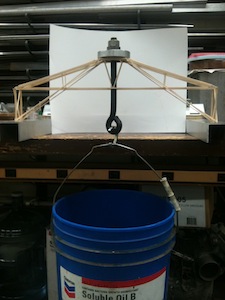Testing of the bridge was conducted within standards of the Science Olympiad Organization (using different equipment). The bridge is supported at either end by a smooth, level surface. A block (in this case a very large washer) rests on top of the bridge, supporting an eye-bolt, which is attached to a five-gallon bucket.  To test the bridge, a material (pea-gravel from UAF parking lots) is loaded into the bucket until the bridge collapses. The bucket, gravel, block, and eye-bolt are then weighed to determine the maximum load that the bridge carried.
To test the bridge, a material (pea-gravel from UAF parking lots) is loaded into the bucket until the bridge collapses. The bucket, gravel, block, and eye-bolt are then weighed to determine the maximum load that the bridge carried.
The results of the test using the calculated values from the Data page is a Lbridge 75.4 lbs and a mbridge of 0.0450 lbs, making the total efficiency 1675, a 47.5%..difference from the calculated value.
The lower-than-calculated result is a good indication that there were factors not considered (or considered incorrectly) in the calculations. However, all of the analyses conducted still gave us a best case scenario where everything behaved perfectly. What did go wrong in the testing is the vertical legs DE and CF deflected out under load, at which point the zero-force member between points A and E failed. In the image to the right, the failed zero-force member spans the base of either leg of the bridge to the large loading washer.
Factors unconsidered are strength and grain inconsistencies in the wood used, joint and member flex, and the geometry not being perfectly matched to the design. To put the results in perspective, a bridge weighing as much as four sheets of computer paper supported a weight equal to two five gallon buckets full of water.
